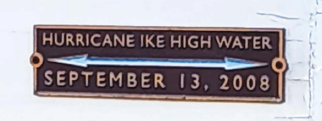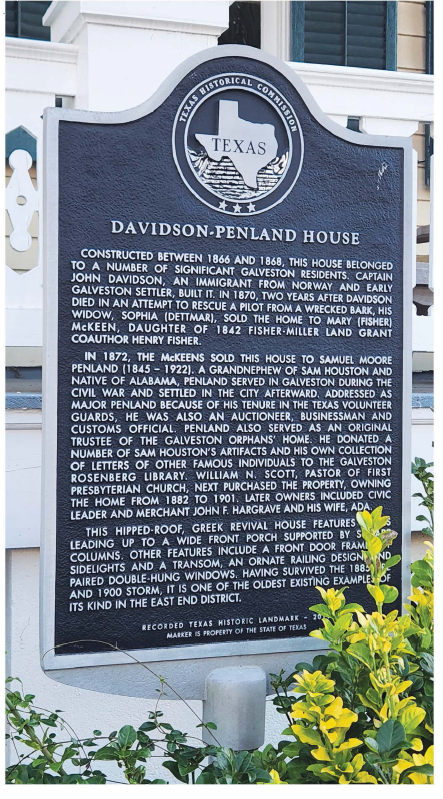The small, Greek Revival one-story home at 1207 Postoffice Street reflects an architectural fashion that was popular in the years leading up to, and several following, the Civil War in Galveston.
Over 150 years old, the house features two side porches that were enclosed in later years and a sidelight and transom framed front doorway. Wide stairs lead up to the front porch trimmed with an ornate railing and supported by four substantial columns.
As one of the oldest homes in the East End Historic District, it is fascinating to think about what residents have witnessed through the large, double-hung windows. The structure survived the 1885 Fire, 1900 Storm, and countless other events.
Oftentimes, the lives lived within the walls of historic homes are as fascinating as the structures themselves. This one, known as the Davidson-Penland House, is such a place.
Bar pilot Captain John Davidson (1820-1868) built the home between 1866 and 1868. After he arrived in 1839, the Norwegian immigrant became one of the city’s earliest settlers and was highly respected in the community for his work ethic.
Unfortunately, he was not destined to enjoy living in his newly built home for long.
Just before Christmas on the afternoon of December 15, 1868, foul weather caused the bark Fortuna from Bremen to founder and take on water offshore. Captain Davidson responded to a distress signal sent by the ship and took the steam tug S.C. Hall out to its side.
While attempting to move from the tug to the Fortuna, the small boat that held Davidson and a boat keeper named Joe White capsized under the bow of the ship. Both men drowned.
 Another boat was lowered from the Fortuna to assist them, but no sign of the small boat or the men could be found.
Another boat was lowered from the Fortuna to assist them, but no sign of the small boat or the men could be found.
The following morning, two schooners went out to the Fortuna and rescued the crew and passengers of the ship. The masts of the ship had been cut to help stabilize her.
Stretches of beach where it was thought the bodies of Davidson and White might have washed ashore were searched to no avail. Days later, a portion of the small boat containing one of Davidson’s gloves was recovered beneath a pier.
Probably due to the possible dangers of his job, Davidson had written a will to bequeath his entire estate to his wife Sophia Dittmar, sometimes spelled Dettmar (1834-1923). The will was written in April 1853, the same month they were married. He was 33 and she was 19 years old at the time.

His widow and three children remained in the house on Postoffice Street until Sophia sold it to Mary Fisher McKeen (1851-1936) in 1870.
Mary’s father, Henry Francis Fisher (1805-1867), was a German immigrant who had been appointed by Sam Houston in 1843 to serve as consul to Bremen.
Through the Fisher-Miller Land Act, he was charged with settling 1,000 immigrants of German, Dutch, Swiss, Danish, Swedish, and Norwegian heritage on more than three million acres of land between the Llano and Colorado Rivers.
Mary lived in the home with her husband Byron McKeen (1839-1899), a grocer with J.L. & A.C. McKeen & Co. on The Strand.
Two years after purchasing the home, the couple sold it to Samuel Moore Penland (1845-1922) in September 1872 for $3,000. Penland was a grand nephew of General Sam Houston, the first president of the Republic of Texas.
Penland was an Alabama native and served in the Signal Corps of the Confederate States Army in Galveston during the Civil War and decided to permanently move to the city.
At the time he purchased the property, he was employed by Park Lynch & Co. auctioneers and commission merchants. He later utilized the same skills to open Penland & Breath with Walter F. Breath and continued in the same line of work. Their office stood on The Strand where Hendley Green Park is today.
Penland was a dedicated mason and served as an original trustee of the Galveston Orphans Home.
Due to his interest in history, Penland collected a large number of letters from famous men of the time, including Ulysses S. Grant, Robert E. Lee, and Walt Whitman. He also collected letters and artifacts from his great uncle Sam Houston.
This collection, which he proudly shared with friends, is now in the archives of the Galveston Texas History Center at the Rosenberg Library.
Penland lived in the home with his wife Cornelia Risley Penland (1849-1876) until her untimely death in September 1876. Afterward, he chose to board at a variety of island properties instead of living in the house.
He most likely rented out the house until he sold it in 1882 to Reverend William Nelson Scott (1848-1919) and his wife Margaret Jane Hanna (1845-1897). Scott was a pastor of the First Presbyterian Church at the corner of 19th and Church streets.
He and Margaret remained in the home with their two daughters and two sons until 1892. They then moved to Winnie Street.
In the following years, the home was owned by several Galvestonians who contributed to the community in their assorted professions.
The ensuing owners included Charles Travis Batterson (1866-1940), an officer of Ullmann, Lewis & Co. importers and wholesale grocers on The Strand. Batterson lived at the house with his wife Clara Wolkarte (1868-1950) and their children.
Cecil H. Compton (1869-1954), an assistant railyard ticket agent whose father had been a veteran of the Battle of Chickamauga, followed in ownership of the home. He eventually sold the property to his brother-in-law and sister, Edward E. Thompson (1869-1939), manager of the American Laundry on Mechanic Street, and Euda Viola Compton (1875-1973).
Thompson then sold the home to Jeremiah “Jerrie” J. Sullivan (1871-1947) of Willis & Sullivan ice cream manufacturers and his wife Mary “Mamie” Margaret Johnson (1880-1925).
When the Sullivans left to continue in the ice cream business in Houston, they sold the home to Mary’s sister Ada Veronica Johnson (1874-1964). She and her husband, civic leader John Francis Hargrave (1880-1922) of Hargrave’s Seed Store, lived in the house.
The house was recorded as a Texas Historic Landmark in 2011. Passersby today will appreciate the significance of the high-water marker from Hurricane Ike in 2008. The sign is easily visible on the right corner of the front porch.
The list of families who have made a home in the historic structure continues, weaving their history along with that of the Davidson-Penland House.
It seems that only in a place like Galveston can one small home connect with so many colorful facets of Galveston history.